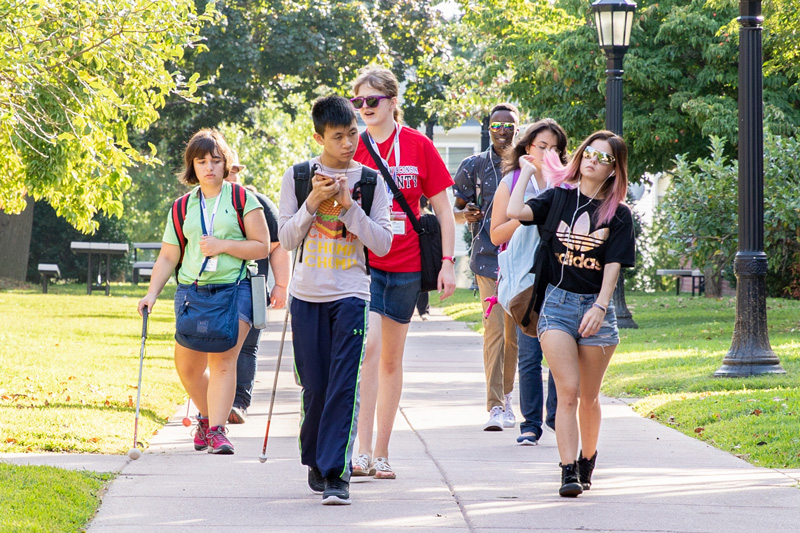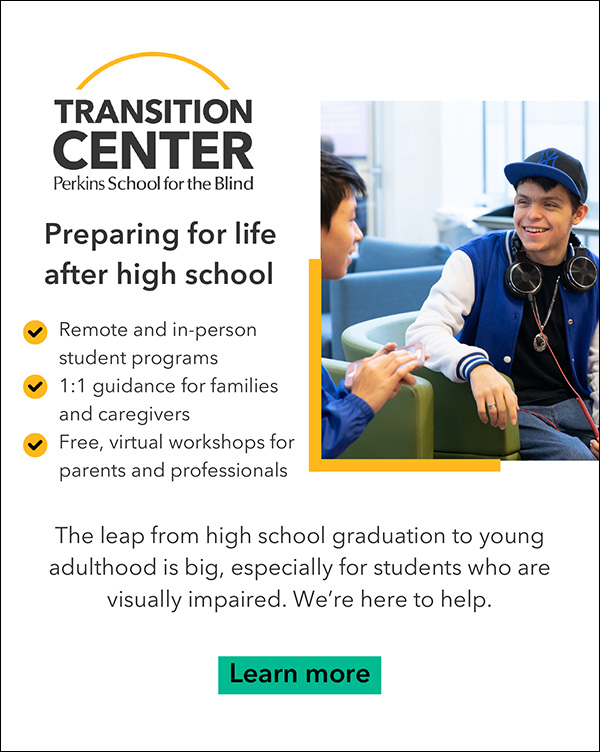According to Petretto et al. (2023), “…autism could currently be considered one of the most commonly reported co-existing developmental disorders in children with blindness or other severe visual impairment.” The etiology, or the biological cause of the blindness, was directly correlated with the percentage of the children being also diagnosed with autism. The co-occurrence of autism can range from 33% in blindness caused by septo-optic dysplasia to as high as 70% of samples of children whose blindness was caused by optic nerve hypoplasia (Molinaro et al., 2020). The proper differential diagnosis is imperative with these children. It opens doors to several additional services and resources, such as insurance coverage.

A group of Perkins School for the Blind teenagers walk across a sunny campus together
According to the CVI Center at Perkins School for the Blind, Cerebral/Cortical Visual Impairment (CVI) is the leading cause of blindness in children. Yet, it is alarmingly underdiagnosed or misdiagnosed because autism and CVI have several overlapping features (as cited in VanBergeijk and LaVoie, 2024). CVI is a brain-based visual impairment caused by damage or interruption to the brain’s visual pathways or processing centers. Parents must find practitioners (pediatricians, ophthalmologists, and neurologists) who are well-versed in CVI and can conduct a differential diagnosis. A diagnosis is the starting point for a treatment plan and dictates the type of medical, educational, vocational, and behavioral interventions that should be a part of the treatment plan.
Some parents are hesitant to pursue a secondary diagnosis of autism. Nikoletta Livingston is an Occupational Therapist at Perkins who works with families to ensure they receive the appropriate diagnoses needed to access relevant services and specialty areas. According to Livingston, “Many families fear the stigma associated with an autism diagnosis, we work with them to challenge misconceptions so that they can access appropriate supports.” In many states, for health insurance to cover certain behavioral therapies and outpatient clinical services like occupational therapy and speech and language therapy, the child must have an autism diagnosis. Without the autism diagnosis, families must pay for these treatments and services out of pocket. These treatments are often long-term and costly. Livingston also advises parents to:
- Ask your medical team if they offer case management within the hospital or someone to help coordinate care and promote team communication
- Create a one page “introduction” of your child, or share a basic information sheet with new team members and providers
- Sign release forms to allow school teams, medical teams, and outside providers to communicate with one another as appropriate
- If you have concerns, don’t “wait and see” but seek answers to your questions; even if your child is young, starting early to gain access to resources and begin planning is important.
Insurance coverage is the key to accessing the health care system and relevant services. As the child reaches transition age, insurance coverage becomes increasingly more important. Under the Affordable Health Care Act, children may stay on their parent’s medical insurance until age 26:
A group health plan and a health insurance issuer offering group or individual health insurance coverage that provides dependent coverage of children shall continue to make such coverage available for an adult child (who is not married) until the child turns 26 (ACA, SEC. 2714. 42 USC, 300gg-14).
This feature of the ACA (colloquially known as Obama Care) is widely known. What most parents of transition-aged youth with disabilities do not know is that their adult child with a disability may continue to be covered by their private medical insurance. The type of disability is immaterial. However, it is incumbent upon the parents to apply for Disabled Dependent Continuation Coverage to their insurance before they reach a certain age. This age varies from state to state, in the Commonwealth of Massachusetts BEFORE their 26th birthday.
A New Model of Educating Students With Visual Impairments and Co-Occurring Conditions
The Perkins School for the Blind has created the Life Launch Program to better prepare transition-aged students with VI and co-occurring conditions such as autism to enter the world of work and independent living. Accessing and navigating medical care is an important part of adult life and living independently. Students in the program will be taught self-advocacy skills, specifically self-advocacy in health care settings, as part of the curriculum. This curriculum covers scheduling appointments, what to expect in various health care settings, insurance requirements, the importance of routine annual medical exams, the creation of a personalized medical folder with the student’s medical history, and preventative health measures (e.g., eating a healthy diet, daily exercise, taking medications, etc.).

A Perkins student smiles as he uses
a microphone to record a podcast
To ensure the Life Launch curriculum includes the necessary components and that families have access to critical resources they need, Perkins collaborates with healthcare experts such as Amy Weinstock, the Director of Insurance Resource Center for Autism and Behavioral Health and Instructor, Department of Psychiatry University of Massachusetts Chan Medical School. The Center provides a whole host of services, including:
- Consulting with schools, agencies, and other organizations on insurance matters pertaining to autism and other disabilities
- Conducting community-based presentations
- Staffing a call center where families and professionals can seek technical assistance on insurance related issues.
- Publishing fact sheets – including a fact sheet on options after age 26 health insurance information. massairc.org/factsheets/healthcare-coverage-for-adults-with-asd-frequently-asked-questions-for-parents/#page-content
- For Massachusetts residents, explaining An Act Relative to Insurance Coverage for Autism (ARICA) massairc.org/factsheets/arica-faq/#page-content
- Maintaining a library of videos of past presentations, including how to keep your child on your insurance after age 26: vimeo.com/871626930
- Hosting bi-weekly lunch and learns for parents and professionals on a variety of insurance related topics
- Access to documents, including Legislation, FAQs, Agency Bulletins, etc.
The Life Launch Program is now accepting applications and will welcome the first class of students to campus in the Fall of 2024. For more information, visit: www.perkins.org/transition-center/life-launch/
Amy joined the Transition Center at Perkins School for the Blind for a webinar on Health Insurance for transition aged youth with disabilities. You can view this discussion here: www.perkins.org/resource-department/transition/
Perkins also offers individualized transition counseling for families and a range of impactful programming and resources designed to assist more academically oriented students with BVI to transition to post-secondary higher education programs, including colleges, universities, and Comprehensive Transition and Post-secondary (CTP) programs. For more information on these programs and resources, visit www.perkins.org/transition-center.
Ernst VanBergeijk, PhD, MSW, is the Founder and President of Ernst Equitable Education Solutions, a consulting firm that helps parents find appropriate educational settings and solutions for their children and helps organizations evaluate and design programming for special needs children, youth, and young adults. He has over 35 years of experience in the special education field, including working as the executive director/dean of two college-based transition programs for students with various disabilities. ErnstEES.com
Alexandra LaVoie, MSOT, is the Director of the Transition Center at the Perkins School for the Blind and is a licensed occupational therapist and special education administrator. Alex has worked in the field of blindness education for over 10 years and has a deep understanding of the unique supports and accommodations that are needed for BVI students to achieve their post-secondary goals. She is passionate about Perkins’ mission to empower students with disabilities to unlock their potential and live as independently as possible. Perkins.org/Transition
References
Molinaro, A., Micheletti, S. Rossi, A., Gitti, F., Galli, J., Merabet, L.B., and Fazzi, E.M. (2020). Autistic-like features in visually impaired children: A review of Literature and directions for future research. Brain Science, 10(8):507. doi: 10.3390/brainsci10080507
Patient Protection and Affordable Health Care Act (PL 111-148) Section 2714 [42 USC 18001]. March 23, 2010.
Petretto, D.R., Lucrarelli, L., Farris, P., Penna, V., Valinotti, S., Pietro, C.G., Gaviano, L., Berti, R., Pili, L., Zolo, B. and Pili, R. (2023). Children with autism spectrum disorders and severe visual impairments: Some general principles for intervention according to the perspective of clinical psychology of disability. Journal of Public Health Research; 12(2):22799036231166314. doi: 10.1177/22799036231166314.
VanBergeijk, E.O. and LaVoie, A. (2024, January). Helping Youth with Autism and Low Vision and Blindness. Autism Spectrum News,
https://autismspectrumnews.org/helping-youth-with-autism-and-co-occurring-low-vision-and-blindness/








